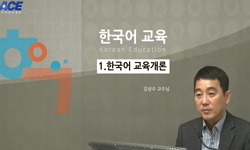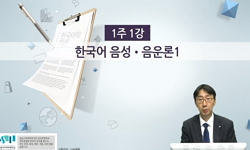In the past decade, Korean as a Foreign Language Education received increasing attention in Korean Language Education field due to two major factors: the rapid increase of culturally and linguistically diverse students in Korea, and the introduction o...
http://chineseinput.net/에서 pinyin(병음)방식으로 중국어를 변환할 수 있습니다.
변환된 중국어를 복사하여 사용하시면 됩니다.
- 中文 을 입력하시려면 zhongwen을 입력하시고 space를누르시면됩니다.
- 北京 을 입력하시려면 beijing을 입력하시고 space를 누르시면 됩니다.

국어교육과 한국어교육의 소통 = Communication between Korean Language Education and Korean as a Foreign Language Education
한글로보기https://www.riss.kr/link?id=A101632783
- 저자
- 발행기관
- 학술지명
- 권호사항
-
발행연도
2015
-
작성언어
-
- 주제어
-
KDC
700
-
등재정보
KCI등재
-
자료형태
학술저널
- 발행기관 URL
-
수록면
141-174(34쪽)
- 제공처
-
0
상세조회 -
0
다운로드
부가정보
다국어 초록 (Multilingual Abstract)
In the past decade, Korean as a Foreign Language Education received increasing attention in Korean Language Education field due to two major factors: the rapid increase of culturally and linguistically diverse students in Korea, and the introduction of the 2012 National KSL(Korean as a Second Language) Curriculum. Naturally, Korean as a Foreign Language Education is distinguished from Korean Language Education concerning its purpose, content, and methods of education. Nonetheless, they also share a common factor in that they both teach the same language, Korean. So this study shall organize the relationship of these two fields by focusing on their academic adjacency and differences. Specifically, this study is based on the analysis of research results over the past decade, which are based on culturally and linguistically diverse students within the domain of Korean language education. Therefore, examining the connections between Korean Language Education and Korean as a Foreign Language Education was possible. Using the academic research information service(http://www.riss.kr), we analyzed various theses and papers on Korean Language Education in a meta-volume statistics mechanism. Through this, we identified that research based on Korean as a Foreign Language Education are showing numerous outcomes within the realm of Korean Language Education. Looking at these results in their respective themes, it was clear that research took place in this very order: teaching methodology research > contents based research > policy and situation related research. Here, an interesting discovery was that the teaching methodology research were more stressed than contents based research. This is because the cultivation of a ‘KSL Education system’ for culturally and linguistically diverse students was an urgent problem that needed to be addressed. These research studies on teaching methodology related reseach mainly emphasizes building a KSL system that supports language education for multicultural students inside the public school. Some examples of this emphasis are studies on the KSL(Korean as a Second Language) Curriculum, the development of standard KSL textbooks, the activation of KSL education programs, and training programs to enhance teachers’ competence. On the other hand, contents based research field which is the base of KSL Education, lacked in research results and appeared to be in an imbalanced state. In this regard, active interaction with the field of Korean as a Foreign Language Education, which has a relatively higher research capacity is definitely required. In addition, this study suggests that Korean Language Education and Korean as a Foreign Language Education must overcome their academic boundaries and join hands in concerning KSL education, thus bringing mutual development in both fields.
참고문헌 (Reference)
1 김정숙, "한국어교육학의 정체성 및 연계학문적 특성 연구" 한국어교육 23 (2) : 39 ~ 59, 2012
2 서혁, "한국어교육과 국어교육의 관계 설정 -상호발전과 세계화를 위한 과제" 국어교육학연구 (30) : 51 ~ 86, 2007
3 이미혜, "한국어 문법 교육의 목표 -국어 문법 교육과의 차별성" 문법 교육 10 : 241 ~ 261, 2009
4 원진숙, "초등학교 다문화 가정 학생을 위한언어 교육 프로그램" 한국초등국어교육 (40) : 157 ~ 188, 2009
5 박영순, "외국어로서의 한국어교육론" 도서출판 월인, 2012
6 백봉자, "외국어로서의 한국어 교육학의 정체성을 다시 생각한다" 국제한국어교육학회 국제한국어교육학회 학술대회논문집 : 21 ~ 31, 2007
7 김봉국, "부산교대 다문화교육과정의 내용과 앞으로의 과제-초등국어교육을 중심으로" 어문학교육 39 : 117 ~ 131, 2009
8 심상민, "다문화 학습자를 위한 (한)국어교육 연구의 동향 분석-(한)국어교육 학위 논문의 연구 경향 분석-" 새국어교육 (98) : 153 ~ 183, 2014
9 원진숙, "다문화 시대 국어교육의 역할" 국어교육학연구 (30) : 23 ~ 50, 2007
10 진선희, "다문화 사회의 국어과 교육 방향" 학습자중심교과교육연구 10 (1) : 403 ~ 428, 2010
1 김정숙, "한국어교육학의 정체성 및 연계학문적 특성 연구" 한국어교육 23 (2) : 39 ~ 59, 2012
2 서혁, "한국어교육과 국어교육의 관계 설정 -상호발전과 세계화를 위한 과제" 국어교육학연구 (30) : 51 ~ 86, 2007
3 이미혜, "한국어 문법 교육의 목표 -국어 문법 교육과의 차별성" 문법 교육 10 : 241 ~ 261, 2009
4 원진숙, "초등학교 다문화 가정 학생을 위한언어 교육 프로그램" 한국초등국어교육 (40) : 157 ~ 188, 2009
5 박영순, "외국어로서의 한국어교육론" 도서출판 월인, 2012
6 백봉자, "외국어로서의 한국어 교육학의 정체성을 다시 생각한다" 국제한국어교육학회 국제한국어교육학회 학술대회논문집 : 21 ~ 31, 2007
7 김봉국, "부산교대 다문화교육과정의 내용과 앞으로의 과제-초등국어교육을 중심으로" 어문학교육 39 : 117 ~ 131, 2009
8 심상민, "다문화 학습자를 위한 (한)국어교육 연구의 동향 분석-(한)국어교육 학위 논문의 연구 경향 분석-" 새국어교육 (98) : 153 ~ 183, 2014
9 원진숙, "다문화 시대 국어교육의 역할" 국어교육학연구 (30) : 23 ~ 50, 2007
10 진선희, "다문화 사회의 국어과 교육 방향" 학습자중심교과교육연구 10 (1) : 403 ~ 428, 2010
11 전은주, "다문화 사회와 제2언어로서의 한국어(KSL) 교육과정의 목표 설정 방향" 국어교육학연구 (33) : 629 ~ 656, 2008
12 원진숙, "다문화 배경 학습자를 위한 KSL 교육의 정체성" 언어사실과 관점 31 : 23 ~ 58, 2013
13 강현화, "다문화 관련 한국어교육학 연구의 쟁점" 배달말 (49) : 375 ~ 399, 2011
14 이영희, "다문화 가정을 위한 한국어교육의 현황과 과제" 세계한국어문학 5 : 91 ~ 132, 2011
15 서울대학교 국어교육연구소, "국어교육학 사전" 대교출판, 1999
16 박영순, "국어교육과 한국어교육" 한국어학 6 (1) : 1 ~ 17, 1997
17 金大幸, "國語敎育과 韓國語敎育의 거리" 국어교육 (112) : 1 ~ 20, 2003
동일학술지(권/호) 다른 논문
-
- 한국어교육학회
- 이대규 ( Dae Gyu Li )
- 2015
- KCI등재
-
- 한국어교육학회
- 박형우 ( Hyeong Woo Park )
- 2015
- KCI등재
-
- 한국어교육학회
- 김성룡 ( Seong Ryong Kim )
- 2015
- KCI등재
-
화법,독서,작문교육 연구의 소통을 위한 커뮤니케이션 연구의 시사
- 한국어교육학회
- 민병곤 ( Byeong Gon Min )
- 2015
- KCI등재




 KISS
KISS






